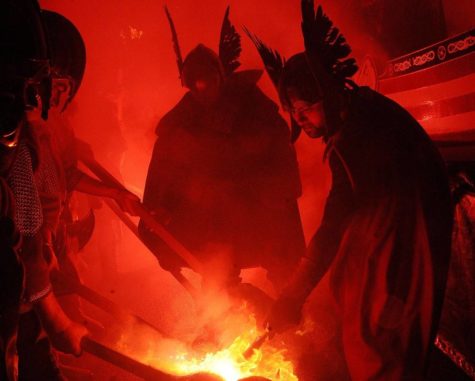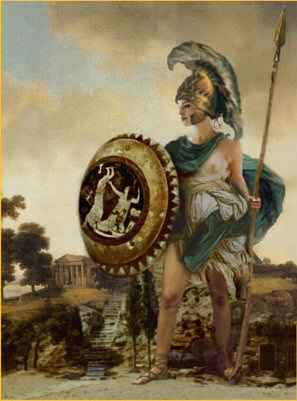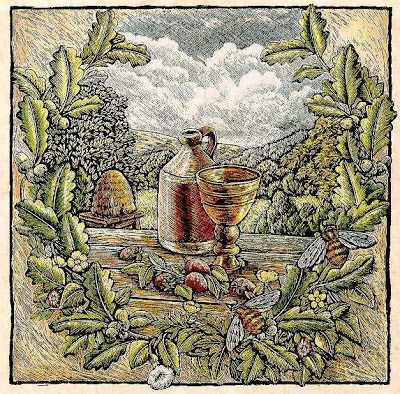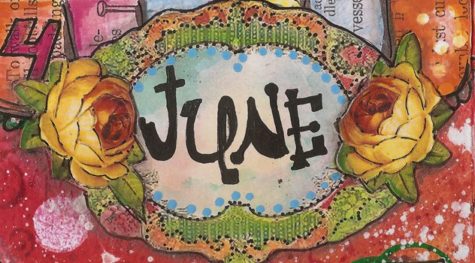Monthly Archives: June 2017
At the outbreak of the Peloponnesian War, the Athenians allowed the founding of a sanctuary for the Goddess Bendis and shortly afterward created a state festival, the Bendideia, for her.The first celebration was held on the 19th of Thargelion (May–June), 429 BC, at the Piraeus, the seaport of Athens.
Many pagan calendars list June 6th as the modern equivalent date for this festival honoring the Moon Goddess of Thrace. Other sources give that her festivals were held on the full moon preceding or coinciding with the solstice – and if so, the dates would vary from year to year.
For a description of the festival we have this excerpt of a conversation between Socrates and a friend describing that festival (from Plato’s Republic):
Sokrates: “I went down yesterday to the Peiraios (Piraeus) with Glaukon (Glaucon), the son of Ariston, to pay my devotions to the Goddess [Bendis], and also because I wished to see how they would conduct the festival since this was its inauguration. I thought the procession of the citizens very fine, but it was no better than the show, made by the marching of the Thrakian contingent [i.e. the mercenary force who policed ancient Athens]. After we had said our prayers and seen the spectacle we were starting for town . . . “
‘Do you mean to say,’ interposed Adeimantus, ‘that you haven’t heard that there is to be a torchlight race this evening on horseback in honor of the Goddess?’
‘On horseback?’ said I. ‘That is a new idea. Will they carry torches and pass them along to one another as they race with the horses, or how do you mean?’
‘That’s the way of it,’ said Polemarkhos, ‘and, besides, there is to be a night festival which will be worth seeing. For after dinner we will get up and go out and see the sights and meet a lot of the lads there and have good talk . . . Let this complete your entertainment, Sokrates, at the festival of Bendis.’
In 1972, the United Nations General Assembly established this observance to raise environmental awareness worldwide. (The event’s June 5 date was chosen to coincide that first year with the start of the 1972 United Nations Conference on the Human Environment, in Stockholm, Sweden.) Each year, a related international event takes place, as well as events in many countries, such as bicycle parades and tree planting.
From: Almanac.com
The Festival of Bellona took place on June 3rd in Campus Martius, near the Temple of Bellona. This was largely just a huge feast in honor of Bellona who had helped them in war. This festival was also a celebration for the dedication of the Temple of Bellona.
One source that talks about the dedication of the Temple of Bellona on June 3rd is in Ovid’s “Fasti”, a six book poem the Roman poet Ovid had published around 8 AD. This quote is found in Ovid’s 6th and final book:
“When two dawns are past, and Phoebus has risen twice,
And the crops have twice been wet by the dewfall,
On that day, they say, during the Tuscan War, Bellona’s
Shrine was consecrated, she who always brings Rome success.”
This goddess did not play a significant role in either myth or legend, and her worship appears to have been promoted in Rome chiefly by the family of the Claudii, whose Sabine origin, together with their use of the name of Nero, has suggested an identification of Bellona with the Sabine war goddess Nerio.
Her temple at Rome, dedicated by Appius Claudius Caecus (296 B.C.) in fulfillment of a a vow during the Third Samnite War with the Samnites and Etruscans, stood in the Campus Martius, near the Flaminian Circus and Porta Carmentalis (the Carmenta gate), and outside the gates of the city. It was there that the senate met to discuss a general’s claim to a triumph, and to receive ambassadors from foreign states. In front of it was the columna bellica, where the fetialis ceremony of declaring war was performed, in which a spear was cast against the distant enemy.
Note:
This native Italian goddess should not be mistaken for the Asiatic Bellona, whose worship was introduced into Rome apparently by Sulla, to whom she had appeared, urging him to march to Rome and bathe in the blood of his enemies. See Day of Blood
~Information compiled from various sources.
Good weather in “Flaming June” is necessary if there is to be a good harvest. Country weather lore states:
- If June with bright sun is blessed, for harvest, we will thank the Goddess.
- If June be sunny, harvest comes early.
- A cold and wet June ruins the rest of the year.
- It is said that if it rains on 27 June, then it will rain for the next seven weeks.
- A wet June makes a dry September.
- A dripping June brings all things in tune.
- If swallows fly near the ground in June, it is a sign of coming rain.
- Bats flying on a June evening are a sign of hot, dry weather the next day.
- A calm June puts the farmer in tune.
- June damp and warm, does the farmer no harm.
- Rain on St Vitus’ Day (June 15), brings rain for 30 days in a row.
According to country lore, it was also claimed that summer doesn’t actually begin until the elder is in flower.
Information collected from: various sources
The original Roman name for this month was Junoius, after the Great Mother Goddess Juno; her counterpart among the Greeks was Hera. The Summer Solstice has been and still is important to many religions and cultures around the world. Not only was it sacred to goddesses of fertility, marriage, and love, but it was considered to be a time when faeries, elves, and many other supernatural beings were abroad in great numbers.
June’s energies are focused on socialization and activity. It is a capricious month, filled with young love, romance, and the companionship of good friends. Any magic aimed at enhancing one’s relationships, communication skills, and the personal energy level necessary for maintaining both will be augmented by working during this month.
The magickal correspondences for June can be found at Magickal Ingredients, here: Correspondences for June.
The June Moon has enormous energies for calling upon and working with elementals of all types. Tides of psychic energy flow freely, enabling even the most staid of people to experience unusual happenings.
On or about 21 June is the Summer Solstice, the festival of Midsummer, the Anglo-Saxon Lith and the Alaban Hefin of the Druids. The Irish name for June is Meitheamh, while the Anglo-Saxon name was Aerra Litha, “before Litha.” The Franks called June Brachmanoth, “break month,” while in modern Asatru it is called Fallow.
The Summer Solstice festival in Slavonic-Russian cultures was called Kupalo and Jarilo. Other names were Kostroma, Sobotka, Kresnice, and Vajano. Kupalo/Kupala was the name of an ancient Slavic deity, originally a goddess, later a god. Special features of this festival were the lighting of fires, the sprinkling of water, and foretelling the future.
The Full Moon festival of Edfu in Egypt honored the goddess Hathor. The cow horns on her head represented the Crescent Moon. Every year at the new Moon the stature of Hathor was taken from her temple at Dendera and transported by boat to the temple of the god Horus at Edfu, arriving on the Full Moon.l This festival celebrated the frank sexual union of the two deities. It was a time of great festivities and very likely human marriages, since it was considered a period of good luck.
The Egyptian festival called the Burning of the Lamps took place in Sais in the temple of Isis. There, in an underground chapel beneath the main temple, was a wooden coffin for the god Osiris. Priestesses, priests, and initiates gathered in this hidden place carrying lamps. Then they marched in a procession around the coffin. The Egyptians said it was the light of the Moon that Isis called upon to bring Osiris back to life. Myth says that when Osiris ascended to the heavens, he went to the Moon.
In Rome, the month of June was sacred to the goddess Juno and therefore a lucky month in which to be married. It was also a time for the Vestal Virgins to cleanse the penus (a sacred vessel) in the Temple of Vesta.
The Roman celebration of the Ludi Piscatari, or festival of the fishermen, was really a blessing of boats. They believed that every boat had a personal spiritual entity. If the powers that went into the boat during its building were not in harmony with the entity, the boat would never ride easily on the water; it would always fight with the wind and the waves. The ritual of blessing the boat harmonized the energies imbued in the vessel, making it lively, willing, and enduring.
The Celtic Day of Cerridwen and her cauldron may have originally been associated with the Summer Solstice. Cerridwen of Wales was a Dark Moon goddess; her symbols were the cauldron, grain, and the Moon. The white, corpse-eating sow, representing the Moon, was one of her animal emblems.
In Tibet, this was a time of masked sacred dances and mystery plays. They had celebrations of the Medical Buddhas and of the Birth of Padmasambhava, who was considered to be a great spiritual teacher.
To the Incas in the Southern Hemisphere, this was the season of the Winter Solstice, since seasons are reversed. They had the Feast of the Sun, or the Inti Raymi, to celebrate the maize harvest. Chanting would last from sunrise to sunset. Inti was the Sun god of the ruling dynasty, represented by a great golden disk with a human face.
As ruler of the high point of the year, the time of the maximum light and minimum darkness, June is the light counterpart of Janus, the ruler of the New Year period. In the Goddess Calendar, the first 12 days of June belong to Hera. On 13 June begins the month of Rosea.
The month of June is the “door of the year,” the gateway to the inner realms. The rune Dag that rules the middle of the month, is the rune of opening, representing the door that excludes bad things and admits only that which is beneficial. The runic year begins in June, with Feoh.
The Celtic Tree Calendar month of Huath (hawthorn) ends on 9 June to be followed on the 10th by the Oak month, Duir. This is a month of strengthening and consolidation of gains. It can also be said to represent the “door” of the year, opening to let the sun shine in. Duir had the sacred color of black.
From: Moon Magick and other sources
“What is one to say about June, the time of perfect young summer, the fulfillment of the promise of the earlier months, and with as yet no sign to remind one that its fresh young beauty will ever fade.” ~Gertrude Jekyl
June takes its name from Juno, the Roman goddess of the hearth and home, and patron wives.. Not surprisingly, June became the traditional month for marriage in Rome, and it continues to enjoy tremendous popularity for weddings today.
Married in the month of roses – June.
Life will be one long honeymoon.
In medieval times June was chosen for the month to marry because the annual baths of the populace took place in May. From May to the following May cleanliness was not a part of their daily ritual as it is today. It was an annual event. So, being that they were relatively clean in June made it a good time to have a special event such as a wedding.
June is also the favored month for flower festivals, likely due to the abundance of earth’s blossoms around this time of year. Other associations include the following:
- Flower: Rose and Honeysuckle
- Meaning: Health and longevity
- Gemstone: Pearl, Moonstone, and Alexandrite
Another precious stone associated with June is the agate, whose traditional rhyme is as follows:
Who comes with summer to this earth,
And owes to June her hour of birth
With ring of Agate on her hand
Can health, wealth and long life command.
June is named after the Roman Great Mother Goddess, Juno; the Greek Hera. The month’s name was originally Junonius. Juno has may attributes, the chief of which is as the Queen of Heaven. This is attribute is ascribed to Frigg in the Northern Tradition and Mary in the Christian.
June has been considered a lucky month since Roman times. As Juno Moneta, guardian of money and wealth, the goddess had a temple dedicated to her on the Capitoline hill in Rome. This contained the mint where coinage was produced. This theme of wealth can also be seen in the runic year cycle: the half-month of Feoh, the time of wealth and abundance, begins on 29 June.
 A man who married in June was guaranteed prosperity, and his wife happiness. This was because the Goddess Juno was associated with money and wealth, and also because she was happily married to Jupiter.
A man who married in June was guaranteed prosperity, and his wife happiness. This was because the Goddess Juno was associated with money and wealth, and also because she was happily married to Jupiter.
Whenever anyone got married in her month, Juno ensured the union was blessed with great happiness. June also has the longest day of the year, and this symbolizes a long and happy marriage.
June’s full moon is sometimes called the Hot or Strawberry Moon.









